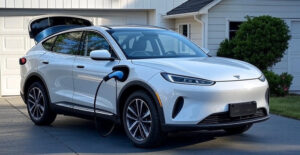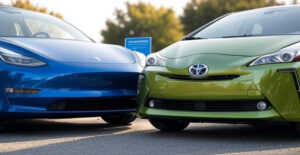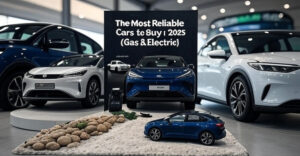Alright, buckle up — if you’re thinkin’ about ditchin’ that gas guzzler for a shiny Tesla in 2025 (or maybe you already got one sittin’ in your driveway), you’ve probably asked the big wallet question: “How much does it actually cost to charge a Tesla these days?” It’s like the one thing every uncle at every BBQ asks when they spot your slick electric car.
Spoiler: It ain’t free — but it’s still way cheaper than watchin’ your hard-earned cash go up in smoke at a gas pump. In this big ol’ guide, I’ll break down home charging vs Supercharging, real-world examples from Tesla owners, tips to slash your bill, hidden costs that’ll sneak up on ya, and a big friendly Q&A at the end so you ain’t stuck googlin’ at 2AM. This ain’t gonna be one of those boring number-crunching lectures — think of me like your EV buddy spillin’ the tea over coffee.
The Short Answer: It Depends
I know, I know — worst answer ever, right? But here’s the deal: the cost of charging your Tesla in 2025 depends on a bunch of stuff:
✅ Where ya live
✅ Your electricity rate at home
✅ If you use Tesla Superchargers
✅ The Tesla model you’ve got
✅ How much you drive
✅ Whether you’re usin’ solar panels or fancy time-of-use electric plans
So let’s break it down like we’re talkin’ over a beer.
The Average Home Charging Cost
Most folks charge at home, ‘cause it’s just so dang convenient. Plug it in overnight, wake up with a “full tank” and ya didn’t even have to get outta your PJs.
In 2025, the average U.S. residential electricity rate is around 15–20 cents per kWh. Let’s run an example:
- Say you’ve got a Model Y with a 75 kWh battery.
- It’s near empty, so you add about 70 kWh.
- 70 kWh x $0.18 (your cost per kWh) = about $12.60 to “fill up” from empty to full.
And that’ll get ya around 300 miles, give or take. Not too shabby when you remember a gas SUV might cost $50–$80 to fill up for the same range, huh?
Real-Life Example: Meet Jake
My buddy Jake lives in Dallas. He’s got solar panels (the show-off) so in the summer, his “fuel” cost is dang near zero during daylight. But when he plugs in overnight, his rate is 12 cents per kWh. He figures he spends about $40–$50 a month drivin’ his Model 3 1,000 miles.
Back in his old pickup days? He dropped $250–$300 easy for the same mileage. Dude never shuts up about it.
Supercharger Costs: Worth the Hype?
Alright, let’s talk road trips and Superchargers. When you can’t plug in at home, Tesla’s Supercharger network is your best friend. But here’s the rub: fast convenience ain’t free.
In 2025, the average Supercharger rate in the US hovers around $0.28–$0.42 per kWh depending on location, local demand, and time of day. So if you’re juicin’ up a 70 kWh charge:
70 x $0.35 = $24.50
Yep, nearly double what you’d pay at home. Still cheaper than gas, but if you rely on Superchargers every day? That’s like buyin’ Starbucks for every meal — you’ll feel it.
Super Off-Peak Rates & Idle Fees
Fun fact: Tesla sometimes gives you cheaper rates for off-peak hours. Roll into a Supercharger at 1 AM? Might save ya a few bucks per kWh. But don’t get too cozy — there’s idle fees. If your car’s done charging and you leave it plugged in, you get charged by the minute.
My friend Lisa learned that the hard way — she fell asleep in her motel room and woke up to a $35 “Oops you forgot” fee. Tesla’s like that strict teacher who whacks ya for not doing your homework.
Home Charging Setup Costs
Here’s a hidden bit folks forget: the upfront stuff. You’ll wanna install a Level 2 charger at home for max convenience. That’ll run ya anywhere from $400 to $1,200 for the unit plus $300–$1,000 for an electrician to wire it up.
But hey — once it’s done, you’ll never look back. Just plug in like a giant phone every night.
How To Lower Your Charging Bill
Alright, money-savers, listen up. Wanna squeeze every penny? Try these:
✅ Time-of-use plans: Lots of utilities offer cheaper rates at night. Plug in after midnight, watch your bill drop.
✅ Solar panels: Big upfront cost, but the payoff is sweet. Free sunshine juice for your Tesla.
✅ Charge to 80% daily: Keeps your battery happy and saves energy wastage.
✅ Monitor vampire drain: Keep Sentry Mode or Climate running only when ya need it.
The Hidden Costs: It Ain’t Just Electricity
Now here’s where folks get blindsided:
🔌 Battery degradation: Your battery loses a bit of capacity each year. Not huge, but means you’ll use a lil’ more juice over time.
🔌 Home charger repairs: They’re pretty reliable, but parts can break down after years.
🔌 Public charging hiccups: Sometimes ya get stuck paying premium rates if you’re road-trippin’ far from home.
True Stories: Real Tesla Owner Bills
James in Oregon:
“I drive about 1,500 miles a month in my Model X. My home rate’s 14 cents/kWh, so I pay maybe $60/month to ‘fuel up.’ My buddy’s F-150 costs him triple that.”
Priya in New Jersey:
“Electric rates here are wild. I pay 22 cents/kWh. So my ‘fill-ups’ cost $15–$20 at home. But that’s still way cheaper than my old minivan. I do hit Superchargers once a month, so tack on an extra $40.”
Tyler in SoCal:
“I got solar so my daily charge is free when the sun’s out. I plug in at lunch while I work from home. Literally pay nothing all summer.”
EV vs Gas: Is It Really Cheaper?
Alright, Captain Obvious here: yes. Even with high electric rates, charging is generally half to a third the cost of gas. But ya gotta plan ahead — if you’re road-trippin’ across Wyoming with no chargers for 100 miles, don’t come cryin’.
Maintenance is cheaper too. No oil changes, spark plugs, or fancy emission checks. Tires? Yeah, they’ll eat rubber faster ‘cause Teslas are heavy and torquey. But still — the long-term savings are solid.

Is It Worth the Cost in 2025?
If you hate gas stations, love the idea of a car that updates itself, and enjoy braggin’ about your “fuel” bill, heck yeah. But be real with yourself: factor in your local electricity prices, charger install costs, and your travel style.
If you’re a daily highway commuter? You’ll save thousands a year. If you’re a city dweller with no garage? Might be trickier — so check out local charging spots.
Final Tip: Plug It In, Walk Away
Biggest mindset shift? Think of your Tesla like your phone. Plug it in overnight, don’t sweat about it. No more random 11 PM gas station runs in the rain.
10–12 Q&A: Charging Costs in 2025
1. How much does it cost to charge at home?
On average, about $10–$15 for a full charge. Depends on your rates.
2. Are Superchargers free?
Nope. They used to be for early adopters, but now they cost around $0.30–$0.40 per kWh.
3. Can I charge my Tesla with a regular outlet?
Sure, but it’s slow as heck. You’ll get maybe 3–5 miles per hour of charge.
4. Should I get a Level 2 charger?
Yep, if you can. It’ll fully juice you up overnight instead of takin’ days.
5. How much does a home charger cost?
Between $400–$1,200 for the unit, plus install.
6. Will my electricity bill skyrocket?
You’ll see an uptick, but it’s usually still way cheaper than gas.
7. Do I pay idle fees at home?
Nope — idle fees are only for Superchargers to stop folks hoggin’ spots.
8. What’s the cheapest time to charge?
Usually late at night if you got a time-of-use plan.
9. Is solar worth it for charging?
If you live somewhere sunny and can swing the upfront cost — 100% yes.
10. How do I track my charging costs?
Use the Tesla app or third-party apps like TeslaFi to see usage and cost.
11. Does battery age make it more expensive?
Slightly, as range drops, you’ll charge more often. But not drastic.
12. Can I charge at any public charger?
Mostly, but some networks charge more than Tesla’s own Superchargers. Always check the rates first.
Final Thoughts
So — how much does it cost to charge a Tesla in 2025? Depends on your plug, your habits, and how much you hate gas stations. But in most cases, you’ll smile every time you pass a $5 gas sign.
Keep your charger clean, plug in smart, and brag responsibly. And if anyone asks, you got the real numbers now — so drop that “It’s basically a dollar a gallon” line at the next BBQ. Happy charging!









